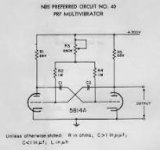Hi all. Searched and didn't see anything on this. Working on a DC power supply for tattoo work. Most I see are compact, and switching. VR, and some also offer CC and/or CV. I also saw some list frequency, but when I investigated, it's the needle frequency that you get with whatever V and I points the motor currently has. But that got me thinking...
What effects could be useful? And how to actually use tube(s) (not just decoration)?
Rectifying 18V@1.5a secondary? Nope. A triode as a pass element, maybe. What if...I use a CC/CV adjustable regulator to get my 20v B+, I could then burn some of the available current through a simple oscillator and load resistor. Say the reg output is 10v@1a. If I had an oscillator, variable from say 20-200hz, burning 400ma, then I'd have a DC voltage with variable frequency power ranging from 600ma-1A left available, for the gun coil in parallel with it.
So I looked for simple triode oscillators. I found this, but no formula.
 Most everything else was RF related, and certainly nothing below 500hz. If anyone could point to low frequency oscillator circuits, or just the basic math of it, it would be greatly appreciated. I saw that one of the oscillator types (Hartley?) use diodes even.
Most everything else was RF related, and certainly nothing below 500hz. If anyone could point to low frequency oscillator circuits, or just the basic math of it, it would be greatly appreciated. I saw that one of the oscillator types (Hartley?) use diodes even.
Thanks much all, this is a fun idea so far-
Loren
What effects could be useful? And how to actually use tube(s) (not just decoration)?
Rectifying 18V@1.5a secondary? Nope. A triode as a pass element, maybe. What if...I use a CC/CV adjustable regulator to get my 20v B+, I could then burn some of the available current through a simple oscillator and load resistor. Say the reg output is 10v@1a. If I had an oscillator, variable from say 20-200hz, burning 400ma, then I'd have a DC voltage with variable frequency power ranging from 600ma-1A left available, for the gun coil in parallel with it.
So I looked for simple triode oscillators. I found this, but no formula.
Thanks much all, this is a fun idea so far-
Loren
Google "vacuum tube multivibrator." This circuit was used in tone generators of electronic organs powered by vacuum tubes. You will need a dual triode tube though. The old Baldwin organ that I had as a teenager used 6SN7's. Later versions used 12AU7's.
Attachments
How about using some thyratrons? https://frank.pocnet.net/other/Philips/Philips_ThyratronsForModernIndustry_1961.pdf
Please keep it safe tough, no mercury vapor or voltages over 60V etc..
Please keep it safe tough, no mercury vapor or voltages over 60V etc..
As a ham, you're likely already familiar, but oscillators are covered pretty well in RDH4:
http://www.tubebooks.org/books/rdh4.pdf
All good fortune,
Chris
http://www.tubebooks.org/books/rdh4.pdf
All good fortune,
Chris
Thank you Chris. I'm definitely familiar with them. Also thanks hydnplayr, no worries about HV, that's one thing I've been working with a long while now. It's just something I've never physically done before, and I'm already good at overcomplicating things...I'm sitting down to check out some of the multivibrator circuits right now. Also, from the RDH the Colpitts oscillators look like something I could employ as well. I'm curious about the inductance measurements of some of my smaller pt transformers, as well as some input transformers I have with half burnt primary. I think my values of L and C will be much larger than typical, since what I'm after is something like 30-few hundred Hz. I'll let y'all know what I come up with crunching the numbers, but I assume this is why George suggested the multivibrators, inductors not necessary. Thanks y'all, you're help is as always much appreciated-
Loren

Loren
- Home
- Amplifiers
- Tubes / Valves
- A different use for tubes...

